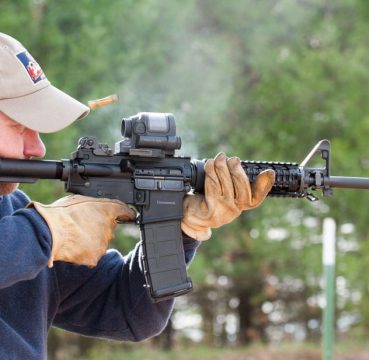What if there was a way you could reduce the recoil of your AR-15 but without increasing wear and tear on the internal components?
It turns out there is such a way: by installing an adjustable gas block system.
Considering the fact that the AR-15 is one of the most customizable rifles in the world, if not the most, it should make perfect sense that there are a variety of different methods that you can use to reduce recoil.
Yes, the AR is already a very light recoiling firearm. But by reducing recoil even further, you can make your follow up shots faster and more accurate. This is why an adjustable gas block can be one of the best upgrades for your AR-15.
We’ll dive into exactly what an adjustable gas block is, why you should consider one, the top qualities to look for, and then three of the best models that you can buy today.
Table Of Contents
What Is A Gas Block?
You might be wondering: what is the gas block to begin with?
The gas block is the piece that fits over the hole on the top of the AR’s barrel. When you fire a round, the gunpowder within the shell casing will explode and propel the bullet down the barrel.
When the barrel passes the whole, some of the hot gas created by the propelled bullet will travel through it, thereby entering the gas tube.
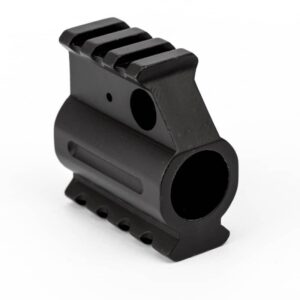
The hot gas will then travel down the tube into the receiver.
This pressure will force the bolt backward, enabling a spent shell casing to be extracted and a new round from the magazine to be loaded into the chamber.
In other words, the gas block is the piece that determines how much hot gas will get pushed into the receiver, which means that it will also directly impact how reliable your AR-15 is.
When the gas tube doesn’t get enough hot gas pushed down the receiver to cycle the action, you’ll have misfeeds.
Fixed vs. Adjustable Gas Blocks
Most gas blocks on a factory configured AR-15 will be fixed. This means that regardless of what type of ammunition you use, a consistent amount of hot gas is going to travel into the tube.
For most purposes, this is completely fine. Standard fixed gas blocks will often allow more gas to travel down the magazine tube than is truly needed; the reason for this is because as gunk builds up in the interior of the AR after repeated firing, the overgassing will enable the weapon to continue functioning reliably anyway.
Unfortunately, this can also result in increased wear on the internal components of the gun, and it can also mean the weapon can be more difficult to clean. When overgassing occurs, it means that the bolt will be rocked back with too much force each time. This is what specifically causes wear and tear on the internal components.
This is where adjustable gas blocks come in. An adjustable gas block permits you to decide how much hot gas enters the gas tube. If you minimize it to prevent overgassing, the bolt will only receive the force it needs to operate, so there is less wear and tear inflicted on the rifle.
Do You Really Need An Adjustable Gas Block?
To be more specific: is an adjustable gas block truly necessary?
The answer is no, it’s not 100% necessary at all. Almost all factory AR-15s have fixed gas blocks only, and they work just fine.
That being said, an adjustable gas block can still improve your overall shooting experience significantly. An AR-15 with a mil-spec set-up will be over gassed, therefore sacrificing lighter and smoother recoil for a guarantee of superior reliability.

But it’s not at all like that an AR-15 with an adjustable gas block will have poor reliability; it’s just a fixed gas block virtually makes it certain. An adjustable gas block will put a lot less stress and wear and tear on your AR-15’s internal parts.
It’s also going to cause a lot less carbon to build up, which means you won’t be needing to use your cleaning kit with your AR-15 as often as you otherwise would have to.
Finally, the biggest benefit to an adjustable gas block (and the number one reason why people choose to have them installed), is because they create less recoil. This permits you to make faster and more accurate follow up shots, which could be a major bonus either for competition use or in a defensive tactical scenario as well.
Top Considerations For Getting An Adjustable Gas Block
Most adjustable gas blocks are built out of either stainless steel or aluminum. Between the two, stainless steel is by far the better option because it’s more durable. An aluminum gas block will not be as long lasting as a stainless steel one.
You also need to make sure you buy a gas block that is of an appropriate size for your barrel. The standard AR-15 barrel has a diameter of .75 inches, and therefore most adjustable gas blocks are designed for a barrel with that diameter.
If your AR-15 has a pencil barrel, on the other hand, then you’re going to want to look for an adjustable gas block that is designed for an AR-15 barrel with a .625 diameter. If your AR-15 has a heavy bull barrel, then you should look for a gas block designed or a .936 diameter.
You also need to take into consideration how your gas block will be attached to the barrel. The most common way to attach it is to slip the block down into the barrel, and then fix it into place on the underside by screws. If you have a free floating handguard on your AR-15, you should get a low profile gas block, which will vanish underneath the rail system.
The 3 Best Adjustable Gas Blocks For AR-15s
Here are three examples of adjustable gas blocks that you can consider for your AR-15 rifle or carbine, regardless of which specific model of AR-15 you have:
Odin Works Adjustable Gas Block
This is a low profile adjustable gas block from Odin Works that gives you twenty different adjustment points, allowing for almost maximum adjustability.
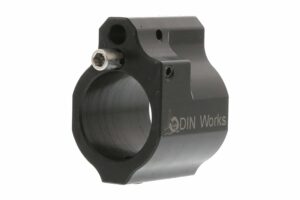
The Odin Works Adjustable Gas Block is also designed for almost all .750-inch AR-15 barrels, but it will not work well with a pistol length gas system or any AR-15 that is loaded with higher pressure rounds.
With a total weight of just over two pounds, it is made out of carbon steel and has a nitride finish for superior corrosion resistance and durability.
In addition to the gas block itself, you will also get a cross pin, detent ball, hex wrenches, and set screws to complete the installation.
Seekins Precision .750 Adjustable Gas Block
The Seekins Precision .750 Adjustable Gas Block is, as the name suggests, designed for AR-15’s with a .750 inch diameter.
It’s designed to ensure the smoothest operation and cycling possible by regulating the amount of gas to a specific bullet weight. If you have lower mass buffers, bolt carriers, and springs in your AR-15, the Seekins Precision will be a great choice.
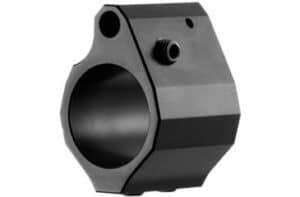
The Seekins Precision is also coated with a melonite finish for superior durability and rust and corrosion resistance.
It’s also incredibly easy to operate and adjust, because all you will need to do is operate the gas regulating screw to either increase or lessen the amount of gas that can enter the gas tube.
You will then use the brass set screws that ship with the Seekins Precision gas tube to lock your setting into place.
Superlative Arms Adjustable Gas Block
The Superlative Arms Adjustable Gas Block is a more unique entry when it comes to adjustable gas blocks.
That’s because most adjustable gas blocks work by restricting the flow of gas that can enter the gas tube, whereas the Superlative Arms works by bleeding the gas out of the block instead.
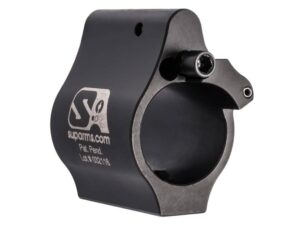
The remaining gas that is left over will then be used to cycle the action.
The benefit to this system is that there will be very little erosion due to a greater lack of carbon build up.
This also makes it a superior option for AR pistols or if you plan on adding a suppressor, because the excess pressure from the hot gas will be exhausted rather than allowed to keep building up in the gun.
Conclusion
By reading this article, you have learned about what an adjustable gas block is, why you should consider getting one, the top qualities to look for, and three examples of models of gas blocks that have those qualities.
Again, an adjustable gas block is not truly necessary for your AR-15 rifle, but it can be a great way to improve your shooting experience by reducing recoil and limiting the build up of carbon in your rifle.
Recommended Reading
Best AR-15 Calibers And Cartridges
How To Build an AR-15 Upper Receiver
